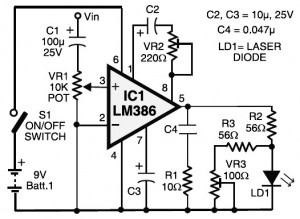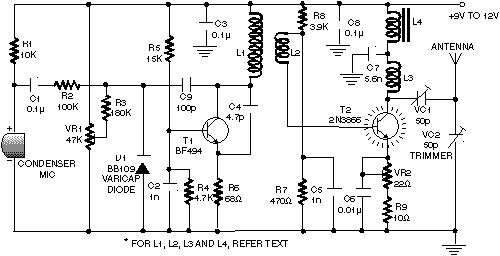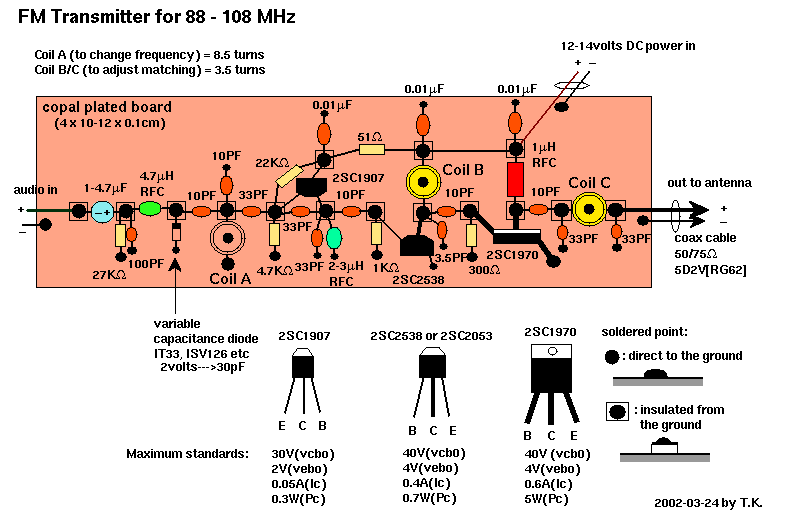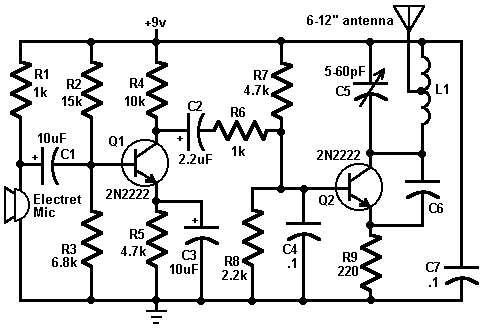
portable FM transmitter
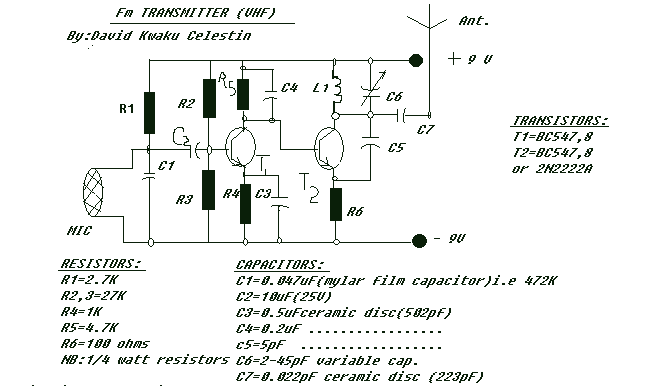
A portable FM transmitter that can be used to replace an FM microphone. This simple transmitter operates from a 9V battery. The old FM mic system was not a perfect solution, so a kit was built with a mixer for the receivers. Using three separate transmitter circuits and a mixer on the receiver, the choir voices were perfectly and cleanly reproduced.
The described portable FM transmitter is designed to enhance audio performance in environments where traditional FM microphones may be cumbersome or ineffective. This circuit operates on a 9V battery, ensuring portability and ease of use. The transmitter is capable of broadcasting audio signals over FM frequencies, allowing for effective communication and sound amplification in various settings, such as a church choir performing acapella.
The transmitter circuit consists of three separate transmitter modules, each responsible for capturing and transmitting audio signals from different sources. This multi-transmitter setup allows for a balanced and enriched audio output, as each transmitter can be dedicated to a specific vocalist or section of the choir. The use of a mixer on the receiver side enables the combination of these individual audio signals, ensuring that the final output is cohesive and of high quality.
Key components of the transmitter circuit likely include an oscillator to generate the FM signal, a modulator to encode the audio signal onto the carrier wave, and an RF amplifier to boost the signal strength for transmission. The choice of components will affect the overall performance, including range, clarity, and resistance to interference.
The receiver circuitry, equipped with a mixer, processes the incoming signals from the multiple transmitters, allowing for real-time adjustments to balance the audio levels. This setup is particularly beneficial in live performance situations where the dynamics of the choir may change, requiring immediate response in sound mixing.
Overall, the implementation of this portable FM transmitter system can significantly improve audio quality in environments where traditional microphones fall short, providing an effective solution for enhancing the listening experience for both performers and the audience.A portable FM transmitter that can be used to replace a FM microphone. This simple transmitter operates from a 9V battery as shown above. I personally built this for a purpose. This is how it happened:- "members of my singing group find it difficult to handle a FM mic in Church. The choir sings in acapella form and the congregation expect us to perform well. The old FM mic system was not a perfect solution, so I built this kit and a mixer for the receivers. using three separate transmitter circuits and a mixer on the receiever, the choir voices were perfect and cleanly reproduced." From the notes I ma 🔗 External reference
The described portable FM transmitter is designed to enhance audio performance in environments where traditional FM microphones may be cumbersome or ineffective. This circuit operates on a 9V battery, ensuring portability and ease of use. The transmitter is capable of broadcasting audio signals over FM frequencies, allowing for effective communication and sound amplification in various settings, such as a church choir performing acapella.
The transmitter circuit consists of three separate transmitter modules, each responsible for capturing and transmitting audio signals from different sources. This multi-transmitter setup allows for a balanced and enriched audio output, as each transmitter can be dedicated to a specific vocalist or section of the choir. The use of a mixer on the receiver side enables the combination of these individual audio signals, ensuring that the final output is cohesive and of high quality.
Key components of the transmitter circuit likely include an oscillator to generate the FM signal, a modulator to encode the audio signal onto the carrier wave, and an RF amplifier to boost the signal strength for transmission. The choice of components will affect the overall performance, including range, clarity, and resistance to interference.
The receiver circuitry, equipped with a mixer, processes the incoming signals from the multiple transmitters, allowing for real-time adjustments to balance the audio levels. This setup is particularly beneficial in live performance situations where the dynamics of the choir may change, requiring immediate response in sound mixing.
Overall, the implementation of this portable FM transmitter system can significantly improve audio quality in environments where traditional microphones fall short, providing an effective solution for enhancing the listening experience for both performers and the audience.A portable FM transmitter that can be used to replace a FM microphone. This simple transmitter operates from a 9V battery as shown above. I personally built this for a purpose. This is how it happened:- "members of my singing group find it difficult to handle a FM mic in Church. The choir sings in acapella form and the congregation expect us to perform well. The old FM mic system was not a perfect solution, so I built this kit and a mixer for the receivers. using three separate transmitter circuits and a mixer on the receiever, the choir voices were perfect and cleanly reproduced." From the notes I ma 🔗 External reference
